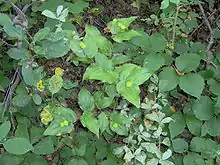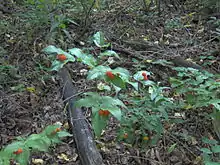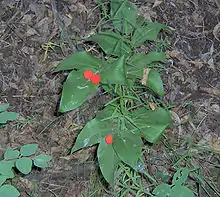Prosartes trachycarpa
Prosartes trachycarpa, the roughfruit fairybells,[2] rough-fruited fairybells or rough-fruited mandarin, is a North American species of plants in the lily family.[3][4] The species is widespread, known from British Columbia to Ontario and south to Arizona and New Mexico.[5][1] One isolated population was reported from Isle Royale in Lake Superior.[4]
| Roughfruit fairybells | |
|---|---|
 | |
| Scientific classification | |
| Kingdom: | Plantae |
| Clade: | Tracheophytes |
| Clade: | Angiosperms |
| Clade: | Monocots |
| Order: | Liliales |
| Family: | Liliaceae |
| Genus: | Prosartes |
| Species: | P. trachycarpa |
| Binomial name | |
| Prosartes trachycarpa | |
| Synonyms[1] | |
| |
The flowers are delicate and hang down. The berry is larger than a Saskatoon, pincherry or chokecherry, about the size of a grocery store cherry or small grape. The rough-fruited fairybell can be found in the same locale as other native fruits such as Saskatoons and chokecherries.[6][7][8] This perennial is 30 centimeters (12 in) to 60 centimeters (24 in) in height. The leaves alternate and are about 3 centimeters (1.2 in) to 8 centimeters (3.1 in) Berries begin yellow, then orange and when fully ripe are red. The surface of the fruit feels fuzzy and velvety.[4]
The images of the rough-fruited fairy bell here were photographed as one was climbing up the riverbank of the South Saskatchewan River, south of Saskatoon. The first nations ate fairybells, and a previous name was dog feet.[9]
The specimen shown in the photograph, Prosartes trachycarpa (rough-fruited fairybell) was found in western Canada. The species is listed amongst plants found in the Prince Albert National Park and Riding Mountain National Park and are considered a common range plant of northern Saskatchewan.[10][11]
Uses
The berries have historically been eaten by Blackfeet Native Americans.[12]


References
- Kew World Checklist of Selected Plant Families
- "Prosartes trachycarpa". Natural Resources Conservation Service PLANTS Database. USDA. Retrieved 14 October 2015.
- Utech, F. H., Z. K. Shinwari, and S. Kawano. 1995. Biosystematic studies in Disporum (Liliaceae-Asparagoideae-Polygonateae). VI. Recognition of the North American section Prosartes as an autonomous genus. Memoirs of the Faculty of Science, Kyoto University, Series Biology 16: 1–41.
- Flora of North America on-line
- Flora of North America v 26 p 144
- Vance, F.R.; Jowsey, J.R.; McLean, J.S. (1977), Wildflowers Across the Prairies, Saskatoon, SK: Western Producer Books, p. 141, ISBN 0-919306-74-8
- Vance, F R; J.R. Rowsey; J.S Maclean; F.A. Switzer (1999), Wildflowers across the prairies With a new section on Grasses, sedges and rushes, Vancouver, British Columbia: Western Producer Prairie Books, p. 25, ISBN 1-55054-703-8
- Wilkinson, Kathleen (1999), Wildflowers of Alberta A Guide to Common Wildflowers and Other Herbaceous Plants, Edmonton Alberta: Lone Pine Publishing and University of Alberta, p. 19, ISBN 0-88864-298-9
- Johnson Kershaw, MacKinnon Pojar (1995), Plants of the Western Boreal Forest and Aspen Parkland, Edmonton Alberta: Lone Pine Publishing and the Canadian Forest Service., p. 83, ISBN 1-55105-058-7
- Innvista, Prince Albert National Park, archived from the original on 2008-07-06, retrieved 2008-08-03
- common range plants of northern Saskatchewan (PDF), retrieved 2008-08-03
- Reiner, Ralph E. (1969). Introducing the Flowering Beauty of Glacier National Park and the Majestic High Rockies. Glacier Park, Inc. p. 118.
| Wikimedia Commons has media related to Disporum trachycarpum. |